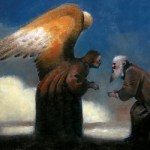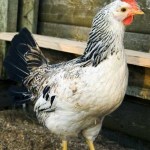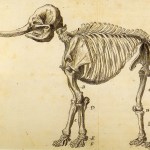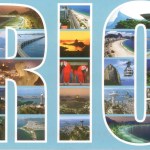darwin
WARNING: Sensationalism ahead! Are you kidding me, Newsweek? They really titled their article Will Physicists Find God? Presumably, the title is named because physicists are searching for the Higgs Particle, and the title is taken after Leon Lederman's (mediocre, IMO) book, The God Particle. Leon's a pretty humorous guy, and was told by his Editor (according to him, anyway) that he couldn't name his book, "The Goddamned Particle," which is what he called the Higgs, so he shortened it.
For better or worse, the article is an interview with Steven Weinberg, one of the most illustrous living…
Myers? Myers? .... Myers? ..... Myers? (He's not here, Ben ... Your producer threw him out.)You know about the incredibly ironic dust up, whereby Expelled! producers kicked PZ myers out of line at a pre-release showing, but failed to notice that Richard Dawkins was standing right next to him. The evidence suggests that this major bit of bad publicity for Expelled! may have led to the movie being pulled from some pre-release showings. It it too early to be sure of this, and there may be several factors other than the utter embarrassment of this incident at play here. For instance, it is…
Photograph of a chicken. Click to see larger version. From PLOS article cited in blog post.
Where and when were chickens domesticated?
From whence the humble chicken? Gallus gallus is a domesticated chicken-like bird (thus, the name "chicken") that originates in southeast Asia. Ever since Darwin we've known that the chicken originated in southeast Asia, although the exact details of which one or more of several possible jungle fowls is the primal form has been debated. The idea that more than one wild species contributed to the early chicken has been on the table for a long time,…
PZ Myers notes that Ken Miller is making a case for the term design in evolutionary biology. Miller simply claims that "design" comes from the usual, expected evolutionary processes (Natural Selection, etc.). PZ is not buying this bill of goods, and neither am I. One way to address this question might be to ask: "What would Darwin do?"
Darwin uses the word quite often in The Voyage (a text I'm closely examining these days) but with only one exception that I found (my search was not perfect) this is typically in connection with cultural things .... the design of a road, for instance. One…
In 1833, Darwin spent a fair amount of time on the East Coast of South America, including in the Pampas, where he had access to abundant fossil material. Here I'd like to examine his writings about some of the megafauna, including Toxodon, Mastodon, and horses, and his further considerations of biogeography and evolution.
In the vicinity of Rio Tercero...
Hearing ... of the remains of one of the old giants, which a man told me he had seen on the banks of the Parana, I procured a canoe, and proceeded to the place. Two groups of immense bones projected in bold relief from the perpendicular…
Everyone knows about Darwin's Finches, of the Galapagos Islands. But of course, Darwin made observations of birds throughout his travels on The Beagle. Here, I present a number of passages from The Voyage that include some of these observations.
Struthio Rhea
I will now give an account of ... the Struthio Rhea, or South American ostrich. This bird is well known to abound over the plains of Northern Patagonia, and the united provinces of La Plata. It has not crossed the Cordillera; but I have seen it within the first range of mountains on the Uspallata plain.... The ordinary habits of the…
Charles Darwin wrote a book called Geological Observations on South America. Since Fitzroy needed to carry out intensive and extensive coastal mapping in South America, and Darwin was, at heart, a geologist more than anything else (at least during the Beagle's voyage), this meant that Darwin would become the world's expert on South American geology. Much of The Voyage is about his expeditions and observations. Part of this, of course, was figuring out the paleontology of the region.
Bahia Blanca is a port at the northern end of Patagonia. Chapter V of The Voyage begins:
THE Beagle…
We are only a tiny ways through the voyage. Need to hurry up! So, let's skip ahead a bit and hit the Gauchos.
Well, you don't really want to hit at Gaucho ... they hit back rather hard....
The Gauchos are the cowboys of the so-called Southern Cone and Pampas. The Gauchos are a Latin American version the horse mounted pastoralists that emerge wherever four things are found together: Grasslands, horses, people and cattle. Like all horse-mounted pastoralists, they have been known to have certain cultural tendencies or traits. These include being incredibly good horse riders. It includes…
Darwin published hundreds of pages of text, but he also kept notebooks many of which come down to us today. They can be roughly divided into two aspects, the Beagle field notebooks of 1831 - 1836, and his later notes. Sometimes these notes are found in a single book, and one way they are told apart (when otherwise undated) is by the orientation of the notes themselves. Darwin wrote "portrait" style in the field, but "landscape" style in the lab.
repost from gregladen.com
Many of the notebooks are preserved at Down House, Darwin's residence. Down House has 14 Beagle notebooks, one…
Eventually, the Beagle headed south to the area of Uruguay and Argentina, still on the Atlantic Coast, where extensive mapping of the coastal waters was required.
The Parana and Uruguay Rivers meet in the Atlantic estuary known as Rio de la Plata. On the north side of this huge body of water is Montevideo, Uruguay, and on the south side, the northern coast of Argentina. There is an interesting story linked with early European exploration of this area. A Spanish ship is the first known European craft to explore La Plata. The ship's captain and a small crew went inland, and never came…
tags: Darwin, Darwin's Birthday, images
The Definitive Darwin.
Image: The Nonist.
A century and a half after Darwin's most important work was published, people still seem to have a hard time wrapping their minds around its implications, or are made nervous and upset by them. The authors at The Nonist thought it was high time that Darwin's image was updated and his ideas put into less technical terms which everyone can understand. With that in mind they modified Bob Peak's poster for Every Which Way But Loose, creating an image better fit to reach the doubtful American public.
Today is Charles Darwin's 199th birthday. Aussie blogger John Wilkins provides an eloquent summation of Darwin's significance:
So remember Darwin not as the discoverer of anything, but as the guy who set off a fruitful, active, complex and ultimately explanatory research program in biology, which continues to become ever more active. Don't make him a saint, an authority, or a hero. He's just a damned good scientist.
Other Darwin miscellanea on the web: For the celebration-minded, Darwinday.org lists local Darwin-related events. The Beagle Project aims to recreate the Voyage of the Beagle, in…
Michael Behe made a guest appearance in Beaver County the other day to engage in a debate on intelligent Design vs. Real Science. He got interviewed by a local reporter, who posed questions to both Behe and his antagonist. Here I provide a few excerpts for your amusement.
First, you may be wondering where Beaver County is. The Beaver County Times Online, like most local newspaper, does not mention where it is. Do you know how much time we bloggers have to spend figuring out where these dumbass local stories come from? You have to use odd clues and make guesses. For instance, the…
The provocative title of this post is the title of a new book, by Ken Ham (founder of the absurd Creation Museum, in the woeful state of Kentucky) . Charles ware is co-author.
The book came out in November, 2007, but is receiving beefed up publicity, presumably to coincide with Darwin Month and Darwin's upcoming birthday.
This is a little like publicizing a book denying that Abraham Lincoln signed the Emancipation Proclamation on Lincoln's Birthday (which, by the way, is the same as Darwin's Birthday).
This issue has been addressed before, but since the publishers of the book have chosen to…
When reading The Voyage it is impossible to miss the observation that much of the time Darwin was engaged in adolescent boy behavior: Pulling the heads off insects, noting how long they would wiggle after cut in half, closely examining the ooze and guts, occupied much of his time. Obviously, careful observation and a strong stomach were not all that was required to think up Natural Selection and his other theories, or the Origin of Species would have been written dozens of times by dozens of grown up kids.
In the following passages, Darwin is still along the Atlantic Coast, in "The…
... is a book by Charles Darwin. But it is also a web page at The Guardian (UK).
150 years ago, Charles Darwin unveiled his theory of natural selection. To mark this anniversary we bring you the definitive guide to the naturalist's great book, with extracts from key chapters and essays from leading scientists and thinkers
Here
What do you eat when you are traveling the world in search of truth about the natural world? Most of the time Darwin ate pretty well...
While traveling through the interior near Rio, Darwin makes note of some of the agricultural practices of the region. He is visiting farms ... plantations .. carved out of the forest.
The chief produce of this part of the country is coffee. Each tree is supposed to yield annually, on an average, two pounds; but some give as much as eight. Mandioca or cassada is likewise cultivated in great quantity.
... that would be Manihot, or cassava, also known as…






